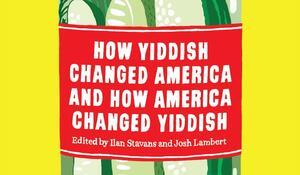What's Yiddish Got to Do with It?
As soon as I started learning Yiddish, I saw and heard it everywhere: sprinkled into the conversations of passers-by, played up for laughs in sitcoms, adorning humorous magnets for sale in my university bookstore. I am certain that many of my experiences are the result of confirmation bias—I am, after all, working on a thesis about Yiddish music for my master’s degree program. But I’ve also stepped into the academic world of Yiddishkeit at a moment of widespread revived interest in the language.
The concept of Yiddishkeit is difficult to define in absolute terms, but Neal Gabler’s explanation in Tablet Magazine has proved to be the most useful for me. Gabler writes, “Yiddishkeit is so large, expansive, and woolly a concept that culture may be too narrow to do it full justice. ‘Jewish sensibility’ comes closer still because it internalizes the notion of Yiddish, places it in the head as well as on the stage and the page, but sensibility is itself a rather loose and elusive idea...In effect, Yiddishkeit isn’t a thing or even a set of things, an idea or a set of ideas...you really can’t define Yiddishkeit neatly in words or pictures. You sort of have to feel it by wading into it.” To that end, Ilan Stavans and Josh Lambart’s new anthology, How Yiddish Changed America, and America Changed Yiddish, is the perfect text to help you test the waters of Yiddishkeit.
Stavans and Lambert have curated an accessible and diverse collection of essays that offer a glimpse into the lives of American Yiddish speakers. The editors note in the foreword, “The aim of this book is to present a very different picture of Yiddish, true to its history, as a language and culture that is—like the Americans who spoke, read, and created in it—radical, dangerous, and sexy, if also sweet, generous, and full of life.” How Yiddish Changed America includes some 63 entries, organized into six distinct sections: “Politics and Possibility,” “The Mother Tongue Remixed,” “Eat, Enjoy, and Forget,” “American Commemoration,” “Oy, the Children!,” and “The Other Americas.” Some entries are as short as a paragraph. Others, like Abraham Cahan’s “A Ghetto Wedding,” are full chapters pulled from previously published works of fiction. Emma Goldman exists within the same pages as Sholem Asch, sandwiched alongside Michael Chabon and Sophie Tucker. The editors also make a point to include voices from the rest of North America and South America, too, because Yiddish movement out of the shtetls was not restricted to just the States.
The unifying (and underlying) question at the heart of How Yiddish Changed America is how the United States has (or hasn’t) changed Yiddish—as a language, as a gateway to a culture, and as shorthand for Jewish identity.
Early on in the text, it’s made clear that American and Yiddish culture exist in dialogue with one another, crossing blurry boundaries and occasionally shapeshifting into something new entirely. Take lox, for example. The first half of Matthew Goodman’s excerpted article “Kosher Chinese?” recounts how carp was the original fish of choice for Jewish immigrants crowding into Eastern seaboard cities. Salmon, however, was more readily available at the turn of the century, and soon salmon cuts were mainstays for delicatessen bagel toppings. Similarly, Manischewitz wine is made with the only type of grapes indigenous to the East Coast: Concord. Within just a few decades, Manischewitz established a firm foothold in the marketplace for kosher wines, and became a recognizably Jewish food item on American supermarket shelves. The story of Jewish American assimilation and upward mobility, then, is also the story of the tastes and preferences of Yiddish-speaking Jews becoming palatable to non-Jewish Americans. “In surveying the assimilation of Jewish food in America,” Goodman laments, “one might wonder what has been gained, and, just as surely, what has been lost.” This reflective piece of historical fact is followed by a cheerful short excerpt by Aaron Lansky, recounting the foods his interview subjects offered him while traveling across the United States in search of Yiddish books. These kinds of juxtapositions are typical throughout How Yiddish Changed America, and remind the reader, constantly, that there is not a single tone, narrative, or experience that can offer a be-all end-all definition of Yiddish influence and longevity in America.
Stavans and Lambert are also savvy to the connections between a recent, revived interest in Yiddish and nostalgia for shtetl life that doesn’t quite match with the realities of the Jewish world prior to the Holocaust. “Some see Yiddish not only as a language but as a metaphor. They note that unlike most other tongues, it doesn’t have an actual address—a homeland, so to speak—or claim, as Isaac Bashevis Singer did when accepting the Nobel Prize in Literature, that it doesn’t have words for weapons…but others see this as an ongoing problem. In particular, it irritates Yiddishists that the language is fetishized, especially by people who don’t speak it.” These words from the foreword struck me deeply and guided my reading as I progressed through the text. The best books force you into a kind of self-dialogue, and I found myself questioning my own motives for studying Yiddish in 2020. Does it help me feel genuinely connected to relatives long gone? Does it give me “credibility” when I speak fondly about radical Jewish organizing and political action? Is it a statement in favor of doykeit, “hereness,” in opposition to Zionism? How Yiddish Changed America pushed me in all the right ways.
I do not think this book belongs solely on the shelves of those with an academic-level interest in Yiddish—readers of all ages and levels of familiarity with the language will find How Yiddish Changed America to be a read with easy access points that can be picked up and flipped through at leisure, or devoured like bagel with lox in one sitting.







